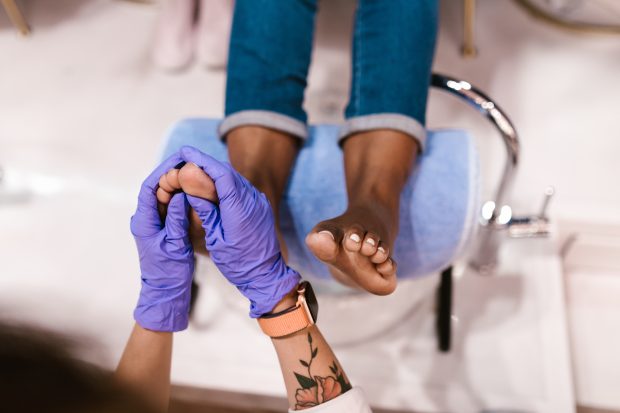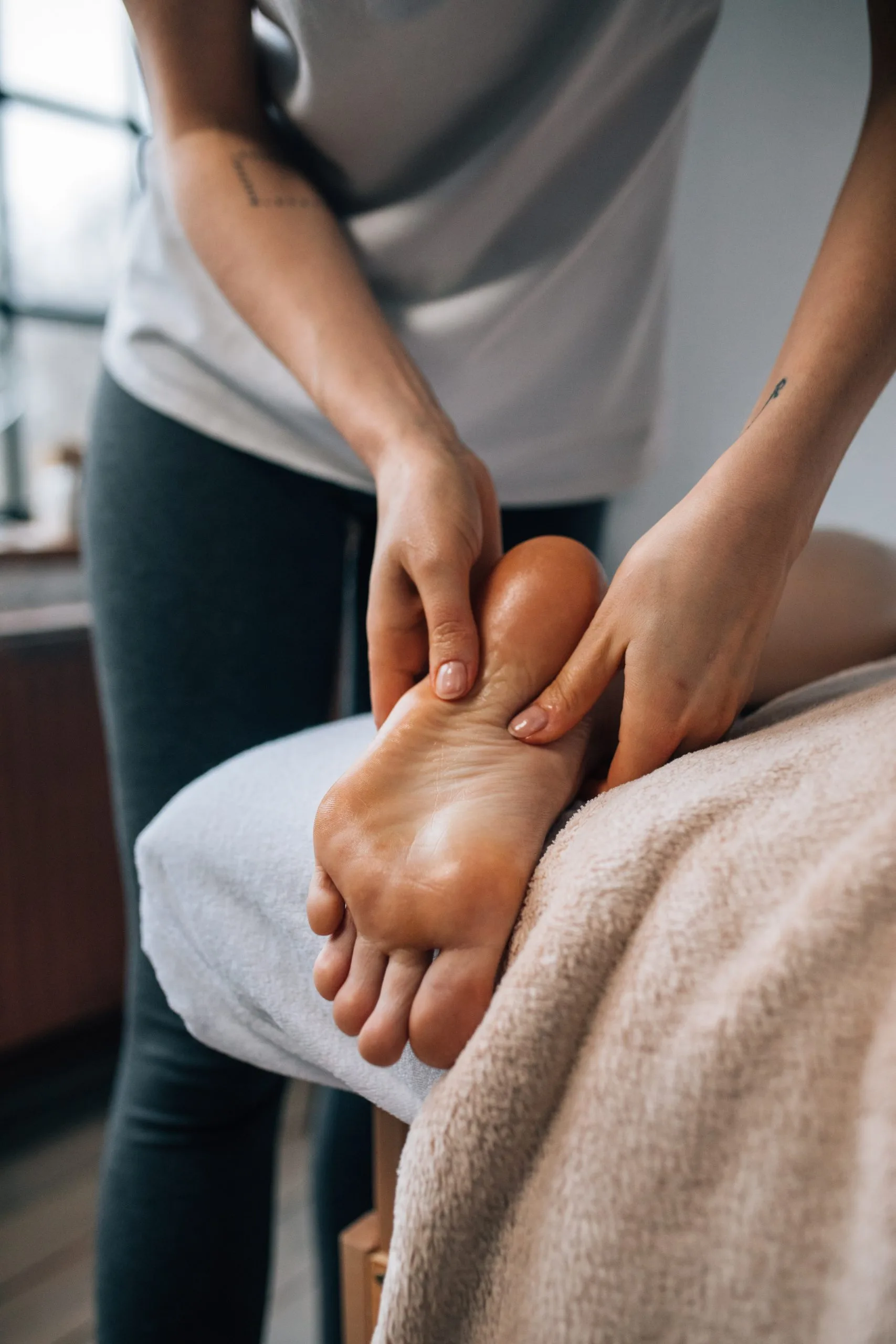Our feet don’t just carry us around, but they also impact our health. With connections to various bodily organs, they have the power to alleviate body ailments. These benefits can be reaped through a relaxing, yet medicinal, technique known as foot reflexology.
What Is Foot Reflexology?
Foot reflexology is an ancient technique that involves applying pressure to specific points on the soles of your feet. This alternative medicine technique dates back to Ancient Egypt and traditional Chinese medicine. It is a non-invasive complementary therapy that focuses on relieving stress by working with the feet.
How Does It Work?
The American Reflexology Certification Board defines reflexology as “a non-invasive, complementary practice involving thumb and finger techniques to apply alternative pressure to reflexes shown on reflexology maps of the body located on the feet, hands, and outer ears.”
In reflexology, pressure is applied to specific reflex points on the foot. These points correspond to various bodily organs. While there aren’t any large-scale clinical studies that demonstrate its health benefits, smaller studies have found that it can help reduce anxiety, ease fatigue, and lower blood pressure.
How Is This Different From Foot Massages?
These two might seem quite similar, but there are some key differences. Massages are defined as a manipulation of tissues to relax the muscles, improve circulation, and relieve tension. This makes massages beneficial for overall health and well-being. Reflexology, on the other hand, uses a “targeted, pressure-point massage” to target specific nerve points that heal various parts of the body.
Benefits of Reflexology
According to Victoria Bodner, LMT is believed to have “different parts of the foot correlated with different organs and parts of the body.” This makes reflexology effective in treating various bodily ailments. These include:
1. Chronic back pain
According to the World Health Organization, back pain is the leading cause of disability in the world. Studies show that about 80% of people at some point in their lives will experience this. It is defined as a pain that persists for longer than 3 months, even after the underlying cause of the pain has been treated. It can affect your upper, lower, or middle back.
A small 2016 study of nurses with chronic lower back pain found that three 40-minute reflexology sessions over two weeks significantly reduced pain severity scores. Another study found that those who engaged in reflexology once a week for six weeks also experienced a reduction in lower back pain.
How to Target It
According to Tish Gilmore, reflexologist and President of The American Reflexology Certification, pay attention to the top of the toe. “You work on that (inner) edge slowly, then slightly deeper, and stop on the tender points to work them out”.
2. Stress and Anxiety
Sanam Hafeez, Psy.D, neuropsychologist says that reflexology can reduce stress and anxiety by not only “rebalancing the lymphatic and endocrine systems” but also “boosting circulation, inducing a state of calm throughout your body.” This leaves your body feeling less stressed and anxious. This is something quite a few studies have backed up.
In a study that was conducted at Worcester Hospital, 28 members of staff were given 40 minutes of reflexology per week for a total of 6 weeks. Of all these participants, 55% showed a reduction in psychological stress. In a research review of 17 studies on the psychological benefits of reflexology, it was concluded that reflexology has the ability to enhance feelings of well-being and help patients.
Another study indicated that foot reflexology has positive effects on anxiety levels. A study published in the journal Complementary Therapies in Clinical Practice found that heart surgery patients who were given 20-minute reflexology treatment once a day for four days reported significantly lower anxiety levels than those who didn’t.
How To Target It
The pituitary gland, also known as the “master gland” of the body, is responsible for regulating the stress hormones cortisol and adrenaline. Targeted reflexology can help reset it. Using your thumb, press and circle the big toe for a few seconds, as this is the glands’ reflexology point.
3. Migraine relief
A migraine is a headache characterized by a throbbing sensation on one side of the head. It tends to be accompanied by other symptoms, including nausea, light-headedness, and sensitivity to both light and sound. This genetic disorder affects about 12% of all Americans, with research showing that it is the sixth most disabling disorder in the world. Women are about three times more likely to be impacted by them, compared to men.
A Denmark trial studied those who were impacted by migraines and had ineffectively been treated with morphine, ketogen, and albergin. Each of these participants received an average of 12 reflexology treatments. While 10% reported feeling slightly better, a whopping 75% said they either felt significant improvement or no longer suffered from migraines at all.
Another study of 84 patients with chronic migraines showed a decrease in the frequency of headaches in reflexological groups, compared to the control group. Another case study of 20 clients living with medically diagnosed migraines indicated the potential for reflexology to relieve the symptoms of migraines after the implementation of six reflexology treatments.
How To Target It
Once again, the big toe is the star of the show. The big toe is the starting point in treating headaches, with sore areas being found on the toes or the base of the toes where they join the rest of the foot. The top of the foot, between the webbing of the big and second toe, is an area that can be sensitive to those who suffer from migraines. Directly under the big toe is the neck reflex and under the small toe is the shoulder reflex, which can aid migraines that feature pain extending into your shoulder and neck.

Photo from RODNAE Productions on Pexels
Do Foot Massages Have Benefits?
Massages aren’t just therapeutic but could be medicinal too. While they may not target specific nerve points to provide healing, massages have been shown to yield a few health benefits too, making this feel-good experience potentially medicinal. These include:
1. Improving circulation
Harvard Medical School has reported that foot massages can improve circulation. Poor circulation occurs when your body’s circulatory system is hindered. If blood vessels in an area close, harden, or narrow, one may develop reduced circulation.
Foot massages boost your circulation, which helps with healing and keeping your muscles and tissues healthy.
While there is limited evidence that backs up this claim, studies show that regular foot massages can be extremely beneficial to those who are affected by diseases that limit blood flow to the extremities (such as diabetes, or Raynaud’s Disease). In these cases, improved circulation to the feet can improve the overall sensation and functioning of the limb.
The most common causes of poor circulation include:
- Smoking: Nicotine can narrow your arteries and put stress on your heart. This can cause circulatory issues throughout your whole body.
- Diabetes: High glucose levels can cause damage to blood vessels over time, which negatively impacts circulation.
- High Blood Pressure: As this can also lead to the narrowing of your arteries, high blood pressure can make it difficult for your heart to freely pump blood and oxygen. This is something that foot massages can help you with too.
2. Lowering Blood Pressure
Also known as hypertension, this condition occurs when the force of the blood against your artery walls is consistently too high. It often has no symptoms, but the most common ones include headaches, blurred vision, and chest pains.
According to the Centers for Disease Control (CDC), nearly half of U.S. adults (47%, or 116 million) have hypertension. Of these, about 92.1 million of them do not have it under control. However, this is a global issue. According to the World Health Organization, an estimated 1.28 billion adults aged 30-79 years globally have hypertension.
A study of healthcare workers who work with elderly people suffering from dementia was conducted. They found that a 10 minute foot massage session three times a week had resulted in lowered blood pressure. According to another study, foot massage interventions led to a significant decrease between diastolic blood pressure, average systolic pressure, and anxiety scores.
This condition is extremely dangerous because if it is not treated, it can cause severe health conditions, such as heart disease and stroke. The most common causes include:
- Smoking
- Being obese
- Having a high-salt diet
- Alcohol consumption
- Lack of physical activity
Those multi-colored foot charts with numbers and arrows in your doctor’s office aren’t just dissections of your feet. They showcase the various pressure points located in our feet, and how they connect to other parts of our body. This makes foot reflexology a possible intervention for both physical and mental ailments.
The Perfect Non-Invasive Intervention?
While clinical evidence for reflexology as a treatment for any condition is pretty thin, it doesn’t mean it doesn’t carry any benefits. And since it’s a non-invasive intervention, it doesn’t present any health risks. However, it is important to remember that while these interventions may exist, it is still important that you speak to your doctor and get their input.
Studies have established that reflexology can be ideal if used in conjunction with the relevant medication for the ailment you are seeking alleviation from. If you do decide to try it, make sure you visit a certified reflexologist. This is especially important if you’ve had any hand or foot problems, or if you’re pregnant. Certain reflexology points have been linked to premature labor, which emphasizes the importance of visiting your doctor first.
Header Image from Koolshooters on Pexels
References
-
Karatas, N. and Dalgic, A.I., 2020. Effects of reflexology on child health: A systematic review. Complementary therapies in medicine, 50, p.102364.
-
Noh, G.O. and Park, K.S., 2019. Effects of aroma self-foot reflexology on peripheral neuropathy, peripheral skin temperature, anxiety, and depression in gynaecologic cancer patients undergoing chemotherapy: A randomised controlled trial. European Journal of Oncology Nursing, 42, pp.82-89.



![women [longevity live]](https://longevitylive.com/wp-content/uploads/2020/01/photo-of-women-walking-down-the-street-1116984-100x100.jpg)










